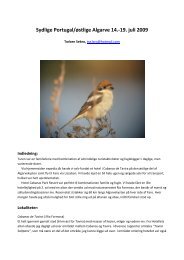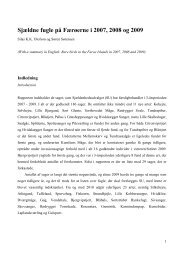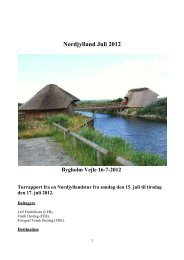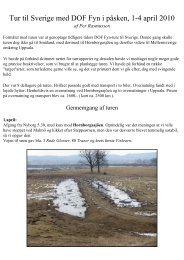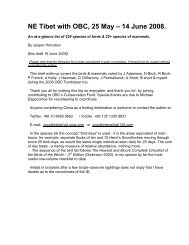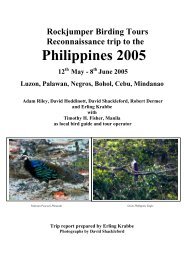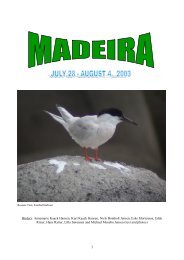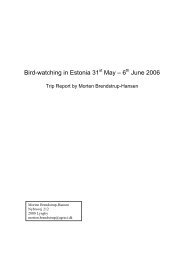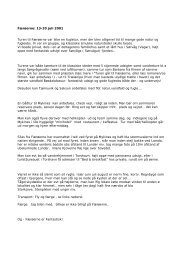TURKEY - a report from a birdwatching trip to Central ... - Netfugl.dk
TURKEY - a report from a birdwatching trip to Central ... - Netfugl.dk
TURKEY - a report from a birdwatching trip to Central ... - Netfugl.dk
Create successful ePaper yourself
Turn your PDF publications into a flip-book with our unique Google optimized e-Paper software.
Resemble Sardinian Warbler S. melanocephala momus (southern Levant), but the duller blackish<br />
cap merges diffusely in<strong>to</strong> mantle (which often has a sandy under<strong>to</strong>ne). In momus, the blacker cap is<br />
sharply divided <strong>from</strong> the grey mantle and the tail is paler. Also, the edges <strong>to</strong> tertials are broader and<br />
diffuser than the sharper and narrower whitish in momus (partly based on Shirihai et al. 2001). Song<br />
resembles other Sylvia-warblers, especially Subalpine Warbler, but is slightly richer with series of<br />
hard notes. The call is a dry rattle.<br />
Menetries´s Warbler ssp. rubescens breeds in SE Turkey <strong>from</strong> Gaziantep and eastwards <strong>to</strong>wards<br />
Lake Van, but might only be regular in the driest hottest areas, with Birezik being the classical site<br />
for the species. Occurs in dry, arid <strong>to</strong> semi-arid lowland with scattered bushes, scrubs and tamarisk<br />
stands, mainly in wadis and often near water, but also in open plantations. The vicinity <strong>to</strong> River<br />
Euphrates might explain the dense population of the Birezik Area.<br />
Ssp. mystacea (the darkest and richest coloured ssp.) occurs rarely in central Eastern Turkey north<br />
of LakeVan in similar habit, but noted up <strong>to</strong> 1700 m.<br />
Total Turkish population 1000-10.000 pairs (Shirihai et al. 2001).<br />
218. Sardinian Warbler Sylvia melanocephala Sorthovedet Sanger<br />
2006: 14.5 1 female Göksu Delta.<br />
Breeds in areas close <strong>to</strong> the Mediterranean eastawrds <strong>to</strong> Gaziantep, in same kind of habits as<br />
Rüppell´s Warbler. Clearly outnumbered by this species in the visited area.<br />
219. Rüppell´s Warbler Sylvia rueppellii Sortstrubet Sanger<br />
2005: 23.5 1 female Demirzili - 23.5 4 males Imamli.<br />
2006: 15.5 5 Demircili – 15.5 5 Imamli – 15.5 1 Imamli – Mut.<br />
2007: 15.5 5 Demirzili – 15.5 5 Imamli.<br />
Found in dry, hilly areas with dense maquis and scattered lower trees used for song-posts. The song<br />
is typical for the family (especially resembling Sardinian Warbler) -a musical, chattering warble<br />
with dry notes intermixed with quick series of clearer notes.<br />
Distributed throughout Western and Southern Turkey eastwards on<strong>to</strong> Gaziantep region Population<br />
estimated <strong>to</strong> between 5000 and 50.000 pairs (Shirihai et al. 2001).<br />
220. Graceful Warbler Prinia gracialis Yndefuld Sanger<br />
2005: 13.5 4 Akgol, Göksu Delta - 21.5 6 along Euphrates south of Birezik - 21.5 1 gravel pits<br />
north of Birezik - 23.5 6 Göksu Delta - 24,5 4 Tuzla Creek.<br />
2006: 14.5 30 Göksu Delta – 24.5 1 Birezik – 25.5 6 Birezik (south of the bridge) – 25.5 7 Birezik<br />
(north of the bridge, along western shores of River Euphrates).<br />
2007: 14.5 15 Akgöl, Göksu Delta – 15.5 20 Göksu Delta – 24.5 15 Gravel pits, Birezik – 26.5 2<br />
Tuzla Gölü S of Adana.<br />
Patchlily distributed in lowlands of S Turkey. Found in dry areas with low scrubs near water. The<br />
song is an insect-like rattling, constantly repeated <strong>from</strong> <strong>to</strong>p of low scrub.<br />
221. Zitting Cisticola Cisticola juncidis Cistussanger<br />
2005: 23.5 2 Göksu Delta.<br />
In <strong>Central</strong> Turkey, mainly restricted <strong>to</strong> the delta areas of Göksu, Ceyhan/Tarsus, where found in<br />
open, grassy areas with scattered bushes.<br />
222. Savi´s Warbler Locustella luscinoides Savisanger<br />
2007: 14.5 3 singing Akgöl, Göksu Delta.




